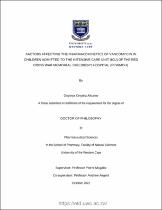| dc.contributor.advisor | Mugabo, Pierre | |
| dc.contributor.author | Akunne, Onyinye Onyeka | |
| dc.date.accessioned | 2023-05-09T13:27:04Z | |
| dc.date.available | 2023-05-09T13:27:04Z | |
| dc.date.issued | 2023 | |
| dc.identifier.uri | http://hdl.handle.net/11394/9870 | |
| dc.description | Doctor Pharmaceuticae - DPharm | en_US |
| dc.description.abstract | Vancomycin is a glycopeptide antibiotic that inhibits bacterial cell wall synthesis by binding to the D-alanyl-D-alanine terminal end of cell wall precursor units preventing the elongation and cross-linkage of the peptidoglycan. Vancomycin is used to treat infections with gram-positive bacteria such as methicillin-resistant Staphylococcus aureus (S. aureus), coagulase-negative staphylococci and penicillin-resistant Streptococcus pneumoniae (S. pneumoniae). It is a time-dependent drug, and its efficacy depends on the duration of pathogen exposure to vancomycin. Low plasma concentration may lead to treatment failure and the re-emergence of bacterial resistance. Vancomycin is known to cause adverse effects at high concentrations. Therefore, it is necessary to monitor plasma concentrations to maintain vancomycin concentration within the therapeutic window. Vancomycin is mainly administered as an intravenous (IV) infusion as it is poorly absorbed from the gastrointestinal system. | en_US |
| dc.language.iso | en | en_US |
| dc.publisher | University of the Western Cape | en_US |
| dc.subject | Pharmacodynamics | en_US |
| dc.subject | Paediatric | en_US |
| dc.subject | Pharmaceuticals | en_US |
| dc.subject | Pharmacokinetics | en_US |
| dc.subject | Cape Town | en_US |
| dc.title | Factors affecting the pharmacokinetics of vancomycin in children admitted to the intensive care unit (icu) of the Red Cross War Memorial Children's Hospital (RCWMCH). | en_US |
| dc.rights.holder | University of the Western Cape | en_US |

